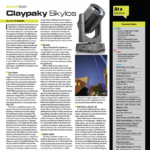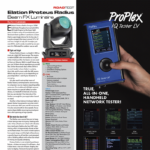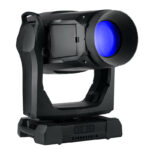Blizzard Lighting is perhaps best known for their extensive range of LED-based products, but with the new Kryo.Morph, the company makes its first move into the realm of arc-lamp-based fixtures. These newer-generation beam units offer an increased set of tools for designers, featuring modes for both a wider, flatter field than a traditional beam unit optimized for pattern projection as well as powerful ACL-style beam projection.
The first thing you’ll see when powering the fixture is a full-color touchscreen on the face of the fixture that allows access to the DMX address, fixture modes and other settings. The screen is easy to read and navigate, and it follows the extremely welcome trend of menus being much more informative than just the four seven-segment LED displays we had in the older days. There are two DMX modes for the light, 16 and 24 channels. The 24-channel mode provides fine (16-bit) adjustment of several parameters; otherwise both modes are functionally identical.
The Kryo.Morph uses a 280W short-arc (1mm) lamp that comes pre-focused in its reflector housing. Despite being pre-focused, the lamp will need to be fine-adjusted in its housing after changing to focus the hotspot. This process is very easy, just loosen four captive Allen screws in the lamp housing and slide it into the appropriate position. Lamp change is also simple, requiring the removal of four screws on the back of the head. These do not remain captive during change, so changing the lamp might best be done when the light is out of the rig. As is the trend for many arc lamps these days, this one lacks an external envelope, and proper lamp thermal management is absolutely critical, so there’s some fancy ductwork to help direct air to where it’s needed most. This lamp has a native color temperature of 7800 Kelvin (which is a touch on the blue side) and a CRI of 75, both of which should be perfectly acceptable for this luminaire’s intended primary application of aerial and gobo effects.
Beam, Spot and Wash Modes
Beam mode is the “default” mode of the light, where all of the power of the lamp is concentrated into a narrow beam. This mode is optimized for aerial effects and projections and has a strongly defined peak in the center for that pencil-thin shaft of light look. When the user selects spot or wash mode, however, a homogenizing filter immediately after the lamp swings into place. This filter smooths the peaks of the beam, providing a nice even field for gobos and wash applications. Output drops somewhat with this filter in place, similar to comparable lights in this category.
Immediately after the homogenizing filter are the dimmer flags, which are a pair of sawtooth metal flags that provide both dimming and strobe functions. The dimmer curve in spot mode is reasonably smooth, and somewhat less smooth in beam mode. This is expected and is a common characteristic of beam projectors of this sort. Dimming is completely mechanical; the lamp stays at full power throughout the dimming range. The unit has the expected strobe functions — a constant-rate strobe up to 15Hz, random strobe and pulse functions are all available.
Next in line is the module that holds the gobos and color wheel, with the module being removable for easy maintenance and cleaning. The color wheel is first in line on the module and features 13 colors plus open, with short gaps in between that result in very usable split colors. The colors are chosen to complement other lights of this class that are on the market, and many of the adjacent colors look good together. There’s a green and yellow next to each other that work well, as well as a magenta and cyan that complement each other. This is a wheel very amenable to being used with effects or chases.
On this same module further up is the static gobo wheel. This is a stamped metal wheel of 14 non-replaceable gobos, including aperture reduction patterns for making the projected beam even narrower. Changes are all very snappy and should work well with effects. Following the fixed wheel is the rotating gobo wheel, which follows the now-familiar system of user-replaceable metal and glass gobos in a holder/carriage system. There are nine rotating gobos plus open, with a good selection of patterns for both aerial projection and break-ups for texture on set pieces or walls. These are all completely indexable and rotatable. You can also morph from one wheel to the other by pulling the focus with both gobo wheels in the optical train at the same time.
Farther up in the chain is the prism module. There are two prisms here, the now-familiar eight-facet circular and a six-facet linear prism. Due the construction of the optical system, they cannot be used at the same time. Both insert into the optical system reasonably fast and provide good image separation, with acceptable levels of fall-off at the edges. Split colors are quite effective when used with either of the prisms, though users should take note that when used as a wash, the lens system moves so far back toward this module that it makes it impossible for the prisms to be in the beam path, preventing their use in wash mode.
The lens system follows the prism module and features two zoom ranges for both spot and beam modes. In beam mode, the zoom ranges from 2.5° to 10°, while in spot mode it goes from 5° to 20°. When in wash mode, the zoom moves out to a wide soft-edged beam, though as mentioned you cannot use the prisms at this zoom range. The zoom and focus are both quick and fast enough to be used with effects.
Power input is via a Seetronic PowerCon-compatible input, although somewhat unusually no through is provided. The total power draw is 470W, which should allow users to run more than one on a circuit. The unit accepts input voltages from 100V-240V and is completely auto-ranging. Pan range is 540° with a tilt range of 270°, with separate pan and tilt locks for transport. Data input is via 3 or 5-pin XLR in and throughs. And the fixture weighs 15Kg (33lbs) and rigs with two of the familiar Omega-style brackets on the base of the light. The construction follows the industry standard of lightweight molded plastic over a metal chassis with removable modules, so I expect that cleaning and maintenance should not be problematic.
With the Kryo.Morph, Blizzard Lighting makes a bold step into the world of arc-lamp fixtures, with a unit made to fulfill multiple roles within a lighting rig. The value of this class of light is clearly its flexibility — it can fulfill not only a spot and beam role, but can function as a wash as well. Beam and spot projectors have different optical and mechanical needs, but they’re blended here in a way that should prove versatile for not only high-end DJs and event companies, but corporate and touring work as well.
At a Glance
Beam, Spot and Wash
Blizzard Lighting’s Kryo.Morph, the company’s first arc-lamp fixture, can morph from a crisp spot or zoomable beam fixture for gobo projections or aerials to a wash with a softer edge. Its user-friendly touchscreen is a nice bonus, and the array of lenses, gobos and filters give lighting designers plenty of tools to work with without breaking the budget.
Blizzard Kryo.Morph
- PROS: Good for budget-conscious projects, low power draw, multiple roles.
- CONS: Output drops when diffusion flag is in.
SPECS:
- Light Source: 280W short-arc (1mm) lamp
- Color Temp: 7800K
- CRI: 75
- Modes: Beam (default), Spot, Wash
- DMX Modes: 16, 24ch
- Dimming: Mechanical
- Strobe Rate: Up to 15Hz
- Color Wheel: 13+ Open
- Gobos: 14 (static), 9+ open (rotating/replaceable)
- Prisms: 2 (8-facet circular + 6-facet linear)
- Zoom: 2.5-10° (beam mode), 5-20° (spot mode)
- Pan Range: 540°
- Tilt Range: 270°
- Size: 22.6 x 14.3 x 9.8” (HxWxD)
- Weight: 33 lbs.
- Total Power Draw: 470W
MSRP: $2,499.99
Manufacturer: Blizzard Lighting
More Info: www.blizzardlighting.com



